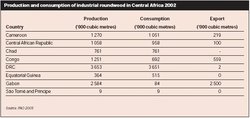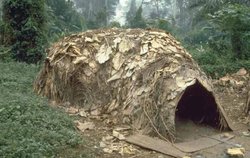Central Africa and forests and woodlands
Contents
- 1 Introduction Table 1: Forest cover as a percentage of total land area (Source: FAO 2005) Forests in Central Africa cover an estimated area of 240 million hectares (ha); these are mainly dense tropical rain forest. The sub-region is dominated by the Congo basin forest ecosystem, which is the second largest forest in the world, second only to the Amazon forest. The ecosystem comprises 200 million ha, about 18 percent of the world’s tropical forests, and hosts about 400 mammalian species and more than 10,000 plant species. As shown in Table 1, most of the countries have considerable forest cover, with Gabon being most forested with 84.7 percent of its total land area under forest cover. Chad is the least forested, with only 10 percent of the land under forest. All the countries, with the exception of São Tomé and Príncipe, are experiencing a gradual decline in the area of their forest cover. (Central Africa and forests and woodlands)
- 2 Endowments and opportunities
- 3 Challenges faced in realizing opportunities for development
- 4 Strategies to improve opportunities
- 5 Further reading
Introduction Table 1: Forest cover as a percentage of total land area (Source: FAO 2005) Forests in Central Africa cover an estimated area of 240 million hectares (ha); these are mainly dense tropical rain forest. The sub-region is dominated by the Congo basin forest ecosystem, which is the second largest forest in the world, second only to the Amazon forest. The ecosystem comprises 200 million ha, about 18 percent of the world’s tropical forests, and hosts about 400 mammalian species and more than 10,000 plant species. As shown in Table 1, most of the countries have considerable forest cover, with Gabon being most forested with 84.7 percent of its total land area under forest cover. Chad is the least forested, with only 10 percent of the land under forest. All the countries, with the exception of São Tomé and Príncipe, are experiencing a gradual decline in the area of their forest cover. (Central Africa and forests and woodlands)
Endowments and opportunities
Forests play a major role in the economies of Cameroon, the Central African Republic, Congo, the Democratic Republic of the Congo, Equatorial Guinea and Gabon, and in the livelihoods of local people. The forest sector contributes, on average, between 5 and 13 percent of the gross domestic product (GDP) of these countries. Up to 60 percent of export earnings for Gabon are from timber products, while for the Central African Republic it is about 50 percent. Gabon is the biggest exporter of industrial roundwood, exporting nearly 97 percent of its total production. Export of medicinal plants is a major foreign exchange earner in Cameroon, with annual earnings of 2.9 million dollars.
Forests and woodlands also play an important role in climate modification, catchment protection and regulation of hydrological networks, and biodiversity. For the local communities, forests and woodlands have multiple uses, which vary extensively with the type of forest, and the community. These range from construction materials, foods, energy, medicines, catchment protection, soil protection, shade, habitat for wildlife and bees, grazing as well as cultural values (including sacred groves, shade, peace trees and plants, meeting places and training areas). Forests play a very important role as carbon sinks, and the Congo basin with its dense forest cover can benefit from carbon trading.
Challenges faced in realizing opportunities for development
Forests and woodlands are declining, mainly due to overharvesting and bush fires, agricultural expansion and overgrazing. User rights in the forests are allocated by governments through administrative or competitive processes. In Gabon, for example, there are 221 concessions over 11.9 million ha or 56 percent of the forest area. Cameroon has allocated 81 percent of its forests to concessions. Although the allocation process takes advantage of market forces, sometimes monitoring and enforcement of regulations in the permit areas by the governments is inadequate, leading to illegal practices such as felling of protected species, wrong classification of logs, felling undersized trees and transportation or removal of more logs than permitted.
Central Africa has an estimated population of close to 80 million inhabitants, of which 65 million currently live in or near the forest. Local communities use bush fires as a technique for agriculture and hunting. Through monitoring, the Global Fire Monitoring Centre (GFMC) has detected an increasing number of fire events in Central Africa, which indicates fire is systematically being employed in land-use change. Central Africa has experienced several prolonged conflicts, which has had various implications for the management of forest resources.
Strategies to improve opportunities
For sustainable forest harvesting to support livelihoods and human well-being, the Central African countries have put in place measures to ensure sustainability of the resource use. Among these are strengthening forest law and governance by:
- Encouraging sharing of information on trade in illegally harvested forest products;
- Participating in international fora and international agreements; and
- Implementing measures to cut corruption.
Strengthening cooperation to harmonize forest legislation and harvesting are also important. The Central Africa Forestry Commission (COMIFAC) presents a good opportunity for all the countries to share experiences and lessons on effective resource management through:
- Creating projects and programmes to evolve forest and environment management, with demonstrated results in the short run;
- Creating monitoring and enforcement systems;
- Providing support to the local forestry and environment NGO’s;
- Sensitizing the local populations in the sustainable use of forest resources and employing them in all forest programmes; and
- Enforcing partnerships at the international level.
Further reading
- FAO, 2002. Global Forest Resources Assessment 2000 – Main Report. FAO Forestry Paper No.140. Food and Agriculture Organization of the United Nations, Rome.
- FAO, 2003. Forestry Outlook Study for Africa African Development Bank, European Commission and the Food and Agriculture Organization of the United Nations, Rome.
- FAO, 2005. State of the World’s Forests 2005. Food and Agriculture Organization of the United Nations, Rome.
- Global Forest Watch, 2000. A first look at logging in Gabon. World Resources Institute, Washington, D.C.
- Maathai, W., 2005. An appeal for the forests of Central Africa. Unasylva No. 220 – COFO 2005: Dialogue into action. Food and Agriculture Organization of the United Nations, Rome.
- UNEP, 2004. Africa Environment Outlook: Case Studies – Human Vulnerability to Environmental Change. United Nations Environment Programme, Nairobi.
- UNEP, 2006. Africa Environment Outlook 2
- White, A. and Martin, A., 2002. Who owns the world’s forests? Forest tenure and public forests in transition. Forest Trends ,Washington, D.C.
|
|
| Disclaimer: This article is taken wholly from, or contains information that was originally published by, the United Nations Environment Programme. Topic editors and authors for the Encyclopedia of Earth may have edited its content or added new information. The use of information from the United Nations Environment Programme should not be construed as support for or endorsement by that organization for any new information added by EoE personnel, or for any editing of the original content. |

